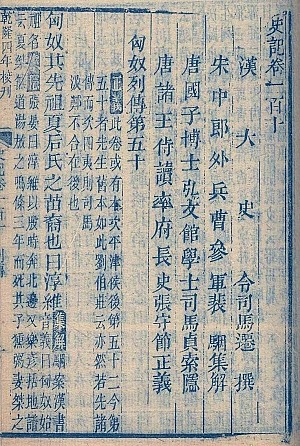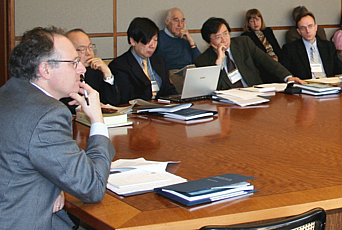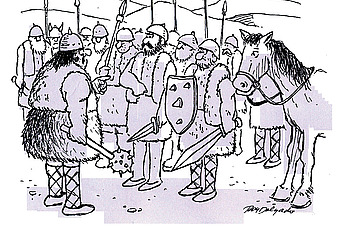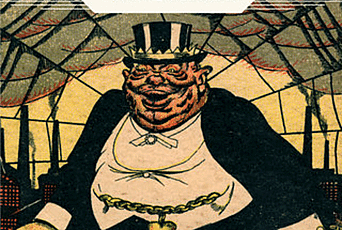The History of Others: Foreign Peoples in Early Chinese Historiography

Sima Qian, the father of Chinese historiography, recorded the history of the nomadic steppe empire of the Xiongnu, a “barbarian” power that emerged on China’s northern frontier during the Han dynasty, in The Records of the Grand Historian. In his text, Sima Qian connected the history of Xiongnu to China and in “attempting to explain the Xiongnu in terms of Chinese history, also gave them a history of their own,” according to Nicola Di Cosmo, Luce Foundation Professor in East Asian Studies in the School of Historical Studies.
Di Cosmo explored the production and characteristics of alien history in the Chinese tradition in a public lecture, “The History of Others: Foreign Peoples in Early Chinese Historiography,” last October. “If all history is history of the present, no history is so transparently history of the present as Chinese history,” said Di Cosmo. “Multinational nations still need unified histories, and one of the most interesting developments of recent Chinese historiography has been the incorporation of the histories of so-called ‘minority nationalities’ in the larger stream of national history. To put it bluntly, we may ask: On what terms does the history of Mongols, Tibetans, Muslims, and the other fifty-two officially recognized nationalities belong to the history of China? And when should we place the beginning of this unified national history?”
In creating a historical past for the Xiongnu that made sense in terms of Chinese written sources, Sima Qian created “a model of ‘barbarian history’ for the first time in Chinese historiography that gave the nomads a historical (rather than cultural or moral) identity vis-à-vis China,” said Di Cosmo. “Sima Qian’s narrative of the nomads, which is still not innocent of some stereotyping, is nonetheless the best ethnographic account of nomads produced in the whole ancient world.”
Why did Sima Qian write about Xiongnu peoples? According to Di Cosmo, “Sima Qian aimed to understand the cycles of greatness and weakness of the nomads so that China could protect itself from them. China and the nomads were destined to alternate with each other in positions of weakness and strength, like the sun and the moon, like yin and yang. The Xiongnu were understood by Sima Qian not just as another culture, or as generic barbarians, but as a special phenomenon, an empire that merited a place in history because it represented a political alter ego to the still young Chinese empire.”
Sima Qian’s revolutionary model for the history of the Xiongnu can be fully appreciated if compared to Ban Gu’s subsequent view of the Xiongnu in History of the Han Dynasty. Ban Gu’s “ideological” view partially reverted to old, pre-imperial models of barbarians whereby, in Di Cosmo’s words, “there is no difference between the Xiongnu and all other barbarians: they cannot be educated or civilized as they represent a different moral universe with which any compromise is futile, and contact is best avoided. What Ban Gu did not (and could not) change was that the ‘barbarians’ had, with Sima Qian, acquired a rightful place in Chinese historiography; nor could he alter the narrative structure of Xiongnu history.”
A “Xiongnu” topos developed in later Chinese history, according to Di Cosmo, which was invoked, for instance, during the Tang dynasty (618–907), when Turks and Uighurs were often compared to Xiongnu leaders, and discussions on foreign policy often were based on historical precedents. Di Cosmo suggested that “we should consider carefully whether Chinese historiography, by collecting not only Chinese views of barbarians, but also historical knowledge of the exploits by nomadic ‘empire-builders,’ may have contributed more than any native oral tradition to the preservation and transmission of a nomadic imperial tradition.” In other words, the history of the nomads invented by Sima Qian is “one that may have been ultimately responsible for the rise of self-conscious nomadic empires on the other side of the Great Wall; empires that so often ruled China, in alternation as Sima Qian prophetically saw, with Chinese dynasties,” said Di Cosmo. “So the question is: Was this a self-fulfilling prophecy? Did the writing of history create real history?”
Nicola Di Cosmo, Luce Foundation Professor in East Asian Studies in the School of Historical Studies since 2003, works on the history of the relations between China and Inner Asia from prehistory to the modern period. He specializes in the cultural, political, and military history of China’s northern frontiers and in the traditions of Inner Asian peoples, in particular ancient nomads, Mongols, and Manchus.


